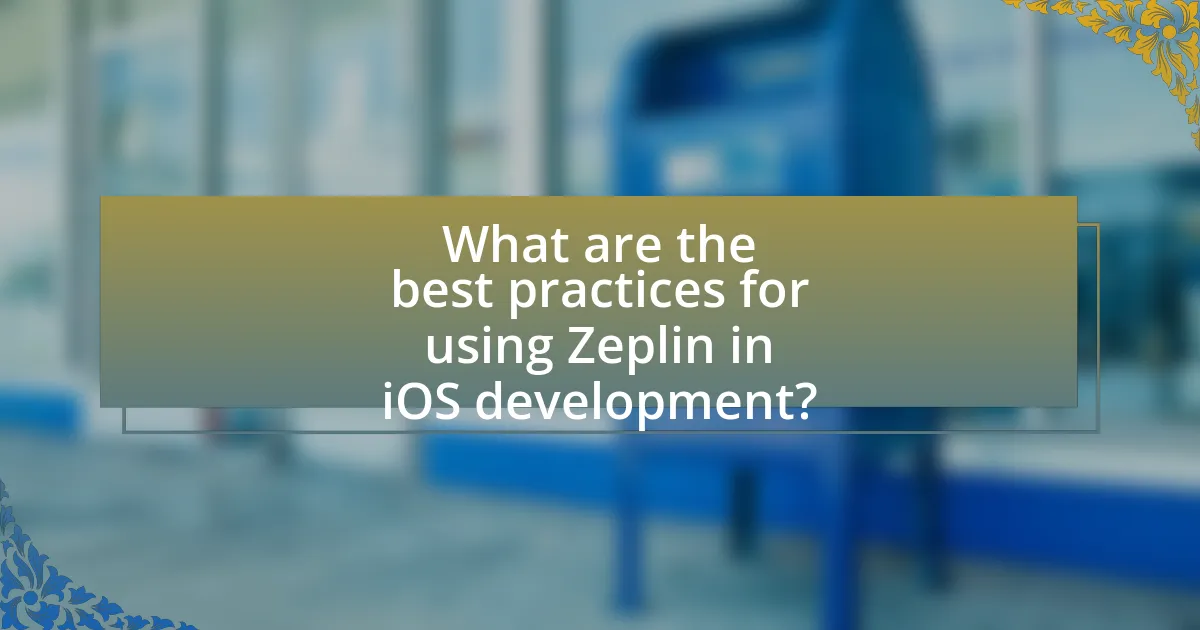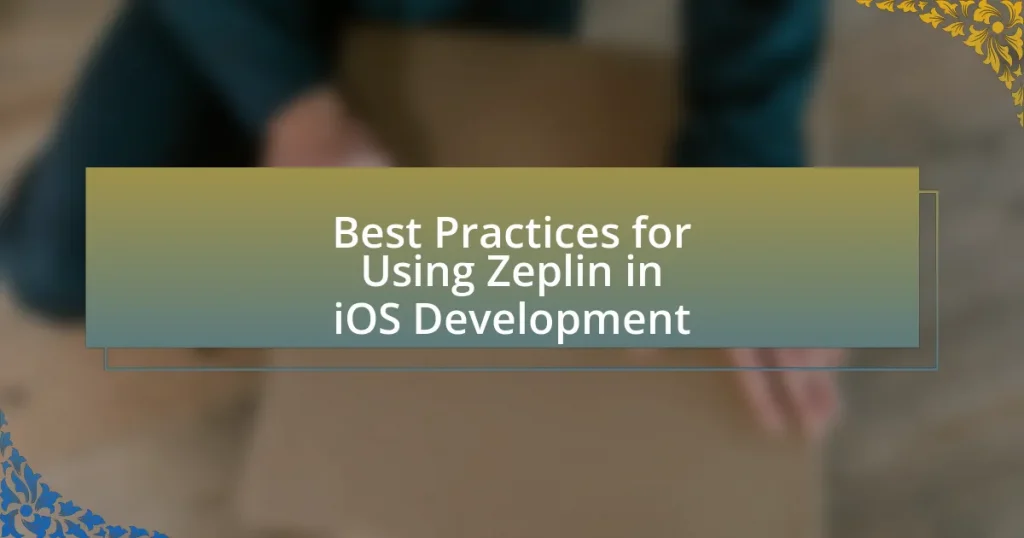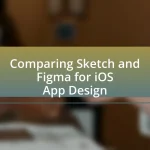The article focuses on best practices for using Zeplin in iOS development, emphasizing the importance of organized design files, style guides, and effective communication between designers and developers. It outlines how Zeplin enhances the development workflow by streamlining collaboration, facilitating design handoff, and providing essential features such as automatic asset generation and integration with popular design tools. Additionally, the article addresses common challenges faced during the design-to-development process and offers strategies for overcoming discrepancies, managing version control, and ensuring accurate implementation of designs. Key tips for maximizing Zeplin’s capabilities and maintaining consistency in iOS applications are also discussed, making it a comprehensive resource for developers seeking to improve their workflow with Zeplin.

What are the best practices for using Zeplin in iOS development?
The best practices for using Zeplin in iOS development include maintaining organized design files, utilizing style guides, and ensuring consistent communication between designers and developers. Organized design files facilitate easier navigation and implementation of design elements, while style guides provide a reference for typography, colors, and components, ensuring uniformity across the application. Consistent communication helps clarify design intentions and reduces misunderstandings, ultimately leading to a smoother development process. These practices enhance collaboration and efficiency, making the integration of design and development more effective.
How can Zeplin enhance the iOS development workflow?
Zeplin enhances the iOS development workflow by streamlining collaboration between designers and developers. It provides a platform where designers can upload their designs, which are then automatically converted into style guides, assets, and code snippets that developers can easily access. This reduces the time spent on design handoff and minimizes miscommunication, as developers receive precise specifications and assets directly from the design files. According to a study by InVision, teams that utilize design collaboration tools like Zeplin report a 30% increase in productivity due to improved clarity and reduced back-and-forth communication.
What features of Zeplin are most beneficial for iOS developers?
The most beneficial features of Zeplin for iOS developers include design handoff, style guides, and automatic asset generation. Design handoff allows developers to easily access design specifications, such as dimensions, colors, and typography, directly from the design files, streamlining the development process. Style guides provide a centralized location for design tokens and components, ensuring consistency across the application. Automatic asset generation simplifies the process of exporting images and icons in various resolutions, which is crucial for iOS development due to the need for different screen sizes and resolutions. These features enhance collaboration between designers and developers, reduce errors, and improve efficiency in the development workflow.
How does Zeplin integrate with other design tools used in iOS development?
Zeplin integrates with various design tools commonly used in iOS development, such as Sketch, Adobe XD, and Figma, by allowing designers to export their designs directly into Zeplin. This integration streamlines the handoff process between design and development teams, enabling developers to access design specifications, assets, and style guides in a centralized platform. For instance, when a designer uses Sketch, they can export artboards to Zeplin with a single click, which automatically generates code snippets and design tokens that developers can use in their iOS applications. This functionality enhances collaboration and reduces the likelihood of discrepancies between design and implementation, as all necessary resources are readily available in Zeplin.
Why is collaboration important when using Zeplin in iOS projects?
Collaboration is important when using Zeplin in iOS projects because it enhances communication and streamlines the design-to-development workflow. Effective collaboration allows designers and developers to share design specifications, assets, and feedback in real-time, reducing misunderstandings and ensuring that the final product aligns with the original vision. For instance, Zeplin provides a centralized platform where design files can be easily accessed, annotated, and discussed, which facilitates quicker iterations and decision-making. This collaborative approach ultimately leads to improved efficiency and higher quality outcomes in iOS development projects.
How can Zeplin facilitate better communication between designers and developers?
Zeplin facilitates better communication between designers and developers by providing a shared platform for design specifications, assets, and style guides. This tool allows designers to upload their designs, which are then automatically converted into a format that developers can easily understand, including measurements, colors, and typography. By streamlining the handoff process, Zeplin reduces misunderstandings and ensures that both parties are aligned on the project requirements. Additionally, Zeplin supports collaboration through comments and feedback features, enabling real-time discussions that enhance clarity and efficiency in the development process.
What role does feedback play in the Zeplin workflow for iOS development?
Feedback is essential in the Zeplin workflow for iOS development as it facilitates communication between designers and developers, ensuring that design specifications are accurately implemented. This iterative process allows developers to receive clarifications and adjustments on design elements, which enhances the overall quality of the final product. For instance, Zeplin enables designers to leave comments directly on design assets, allowing for real-time feedback and reducing the likelihood of misinterpretations. This structured feedback mechanism ultimately leads to a more efficient workflow and a product that aligns closely with the original design vision.
What are the common challenges faced when using Zeplin in iOS development?
Common challenges faced when using Zeplin in iOS development include issues with design handoff, version control, and integration with development tools. Designers may struggle with accurately translating design specifications into code, leading to discrepancies between the intended design and the final product. Additionally, managing multiple design versions can create confusion, especially when updates are frequent. Integration with development environments, such as Xcode, may also present difficulties, as developers need to ensure that assets and styles are correctly implemented. These challenges can hinder workflow efficiency and affect the overall quality of the application.
How can developers overcome issues related to design discrepancies in Zeplin?
Developers can overcome issues related to design discrepancies in Zeplin by ensuring consistent communication with designers and utilizing Zeplin’s features effectively. Regular check-ins with designers help clarify design intentions and address any misunderstandings early in the development process. Additionally, developers should leverage Zeplin’s style guides, measurement tools, and export options to maintain fidelity to the original designs. For instance, using the measurement tool allows developers to verify spacing and alignment, reducing the likelihood of discrepancies. By actively engaging with the design specifications provided in Zeplin, developers can align their implementations more closely with the intended designs, thus minimizing errors and enhancing the overall quality of the final product.
What strategies can be employed to ensure accurate implementation of designs from Zeplin?
To ensure accurate implementation of designs from Zeplin, developers should adopt a systematic approach that includes thorough review of design specifications, consistent communication with designers, and utilization of Zeplin’s built-in features. Reviewing design specifications allows developers to understand dimensions, colors, and typography precisely, which minimizes discrepancies during implementation. Consistent communication with designers facilitates clarification of design intent and adjustments, ensuring alignment between design and development. Utilizing Zeplin’s features, such as style guides and exportable assets, streamlines the process by providing developers with the necessary resources directly from the design files, thus enhancing accuracy and efficiency in the implementation process.
How can developers maximize the use of Zeplin in their iOS projects?
Developers can maximize the use of Zeplin in their iOS projects by integrating it into their design workflow for seamless collaboration between designers and developers. This integration allows developers to access design specifications, assets, and code snippets directly from Zeplin, which streamlines the handoff process and reduces misunderstandings. Additionally, utilizing Zeplin’s style guide feature ensures consistency in UI elements across the project, as it provides a centralized location for design tokens and guidelines. By leveraging Zeplin’s version control, developers can track changes in designs and maintain alignment with the latest updates, enhancing project efficiency and accuracy.
What are the key tips for organizing projects effectively in Zeplin?
To organize projects effectively in Zeplin, utilize clear naming conventions for projects, screens, and components. This practice enhances collaboration by ensuring that all team members can easily identify and access the necessary assets. Additionally, categorize designs into relevant sections or groups within Zeplin to streamline navigation and improve workflow efficiency. Implementing version control by maintaining a history of design updates allows teams to track changes and revert to previous versions if needed. Furthermore, integrating Zeplin with project management tools like Jira or Trello can facilitate better task tracking and communication among team members. These strategies collectively contribute to a more organized and efficient project management experience in Zeplin.
How can developers utilize Zeplin’s style guide features for consistency in iOS apps?
Developers can utilize Zeplin’s style guide features by creating a centralized repository of design elements, which ensures consistency across iOS apps. This repository allows developers to access standardized colors, typography, spacing, and components directly from the style guide, reducing discrepancies in design implementation. By integrating these elements into their development workflow, developers can maintain uniformity in the user interface, leading to a cohesive user experience. Furthermore, Zeplin automatically generates code snippets for these design elements, streamlining the coding process and minimizing errors associated with manual coding. This approach is validated by the fact that consistent design practices enhance user satisfaction and engagement, as supported by research indicating that cohesive design can improve usability and brand perception.
What are the best practices for exporting assets from Zeplin for iOS development?
The best practices for exporting assets from Zeplin for iOS development include ensuring that assets are exported in the correct resolution, using appropriate file formats, and organizing assets effectively. Exporting assets at 1x, 2x, and 3x resolutions is crucial for supporting various device screen sizes, as iOS devices utilize different pixel densities. PNG is the recommended file format for images due to its lossless compression and support for transparency, while SVG is ideal for vector graphics. Additionally, organizing assets into clear categories and naming conventions enhances collaboration and efficiency, making it easier for developers to locate and implement the necessary assets in their projects.
How can developers ensure they are exporting the correct asset formats for iOS?
Developers can ensure they are exporting the correct asset formats for iOS by adhering to Apple’s Human Interface Guidelines, which specify the required formats and resolutions for various asset types. For instance, images should be exported in PNG or JPEG formats, while vector graphics can be exported as PDF. Additionally, developers should utilize Zeplin’s export settings, which provide options tailored for iOS, ensuring assets are correctly sized and formatted for different device resolutions, such as @1x, @2x, and @3x. This adherence to guidelines and the use of Zeplin’s features help maintain consistency and quality across iOS applications.
What steps should be taken to manage version control of assets in Zeplin?
To manage version control of assets in Zeplin, follow these steps: first, ensure that all design files are consistently updated in the design tool before exporting to Zeplin. This practice maintains a single source of truth for design assets. Next, utilize Zeplin’s versioning feature by creating new versions of the project whenever significant changes are made. This allows team members to reference previous iterations and track changes effectively. Additionally, communicate with your team about updates and changes through comments and notes within Zeplin, ensuring everyone is aligned on the latest asset versions. Finally, regularly archive older versions of assets to keep the workspace organized and reduce clutter. These steps enhance collaboration and maintain clarity in asset management within Zeplin.
What troubleshooting tips can help resolve common issues with Zeplin in iOS development?
To resolve common issues with Zeplin in iOS development, ensure that the latest version of Zeplin is installed, as updates often fix bugs and improve functionality. Additionally, check the internet connection, as a stable connection is essential for syncing designs. If designs are not appearing, verify that the correct project is selected and that the design files are properly exported from Sketch or Figma. For issues related to missing assets, confirm that all necessary layers are marked for export in the design tool. If problems persist, restarting the Zeplin application or the device can often resolve temporary glitches. These troubleshooting steps are effective because they address the most frequent causes of issues reported by users in the Zeplin community.











